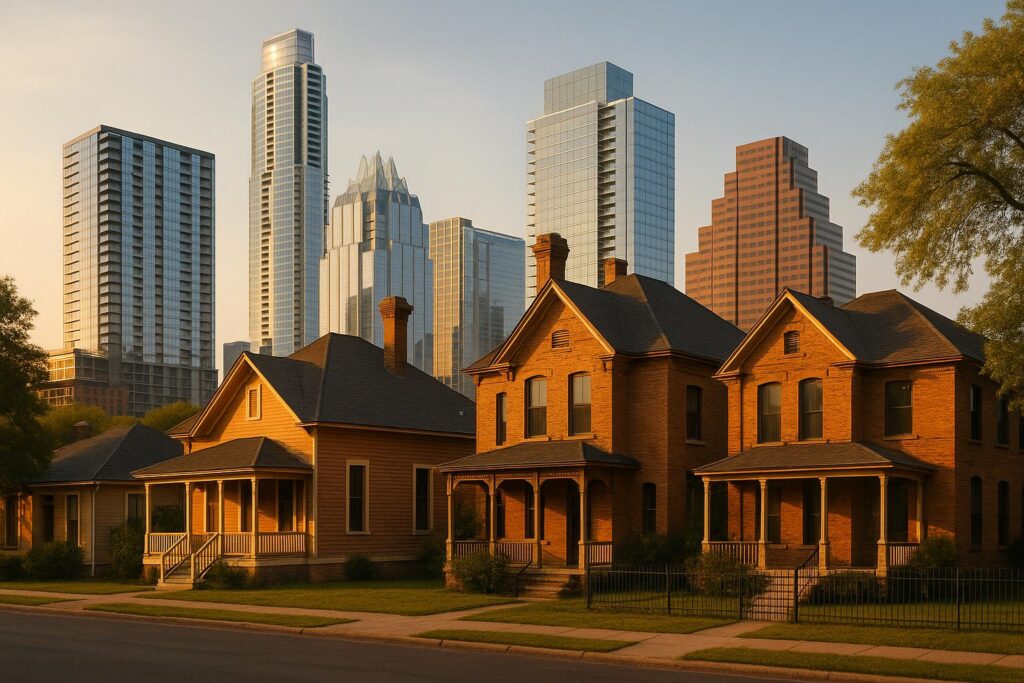Navigating Austin’s rush hour can be tricky, but with the right strategies, you can save time and reduce stress. Here’s what you need to know:
- Morning Peak Hours: 7:30 AM–9:00 AM (worst at 8:15 AM).
- Evening Peak Hours: 4:00 PM–6:30 PM (worst at 5:00 PM–5:45 PM).
- Delays on Major Routes: I-35 and Mopac Expressway see severe slowdowns, with speeds dropping below 20 mph during peak times.
- Commute Tips: Leave 30 minutes earlier or later than peak hours to cut delays by up to 40%.
Quick Highlights:
- Short Downtown Commutes: Neighborhoods like Travis Heights (10–15 min) and Mueller (15–20 min) are ideal.
- Long Suburban Commutes: Round Rock and Cedar Park can take 50–65 minutes during rush hour.
- Public Transit: CapMetro offers reliable options like the MetroRail Red Line (55 min to Leander) and MetroRapid buses (35–45 min end-to-end).
Pro Tip: Use traffic apps, explore alternative routes, and consider public transit or scooters for smoother commutes.
I-35 vs. SH130: What’s the best commute into downtown Austin?
Downtown Austin Traffic Patterns
Traffic in downtown Austin plays a major role in commute times. Recent monitoring sheds light on congestion trends and delays.
Peak Traffic Hours
Morning rush hour hits its worst between 7:30 AM and 9:00 AM, peaking at 8:15 AM. In the evening, traffic builds from 4:00 PM to 6:30 PM, with the heaviest congestion occurring from 5:00 PM to 5:45 PM. On I-35, speeds often drop below 20 mph during these times.
Mopac Expressway (Loop 1) shows a similar pattern but with slight timing differences:
| Time Period | Average Speed | Congestion Level |
|---|---|---|
| 7:30-8:30 AM | 15-25 mph | Severe |
| 8:30-9:30 AM | 25-35 mph | Moderate |
| 4:00-5:30 PM | 10-20 mph | Severe |
| 5:30-6:30 PM | 20-30 mph | Moderate |
Causes of Traffic Delays
Several factors contribute to downtown Austin’s traffic delays:
- Construction projects, including the I-35 expansion and work in the 2nd Street District, significantly disrupt traffic flow.
- Events at venues like the Austin Convention Center or ACL Live draw large crowds, increasing congestion.
- Rainy weather can extend commute times by 25-35%.
- Accidents and vehicle breakdowns on major routes, such as Cesar Chavez Street, lead to additional delays.
Typical Delay Times
Delay times vary depending on the route, direction, and time of day. For example, northbound travel on I-35 during the evening rush can stretch a 15-minute trip into 35-40 minutes.
Here’s a breakdown of delays during peak hours on key routes:
| Route | Morning Rush | Evening Rush |
|---|---|---|
| I-35 North | +15-20 min | +25-30 min |
| I-35 South | +20-25 min | +15-20 min |
| Mopac North | +15-25 min | +20-25 min |
| Mopac South | +20-30 min | +15-20 min |
| Cesar Chavez | +10-15 min | +15-20 min |
Leaving 30 minutes earlier or later than peak times can cut commute times by as much as 40%. This data provides a useful foundation for comparing travel times across different parts of the city.
Travel Times by Area
Austin’s commute times vary widely depending on the area, with noticeable differences between neighborhoods close to downtown and suburban regions.
Quick Downtown Commutes
Some neighborhoods near downtown Austin offer shorter commute times, even during rush hour. For example, Mueller, just 3 miles from downtown, takes about 15-20 minutes during peak hours. Similarly, Travis Heights and Bouldin Creek provide manageable travel times of 10-15 minutes to downtown offices.
| Neighborhood | Distance | Morning Rush | Evening Rush |
|---|---|---|---|
| Mueller | 3 miles | 15-20 min | 15-20 min |
| Travis Heights | 2.5 miles | 10-15 min | 12-18 min |
| Bouldin Creek | 2 miles | 10-15 min | 15-20 min |
| Clarksville | 1.5 miles | 8-12 min | 10-15 min |
| East Cesar Chavez | 1 mile | 5-10 min | 8-12 min |
However, suburban commutes are often much longer, especially during peak hours.
Longer Suburban Routes
Suburban residents face significantly longer travel times. For example, commuting from Round Rock to downtown via I-35 can take 45-60 minutes during the morning rush, compared to just 25-30 minutes during off-peak hours. Similarly, Cedar Park commuters experience delays on US-183, with travel times stretching up to 65 minutes during peak periods.
| Suburb | Off-Peak | Morning Rush | Evening Rush |
|---|---|---|---|
| Round Rock | 25-30 min | 45-60 min | 50-65 min |
| Cedar Park | 30-35 min | 50-65 min | 45-60 min |
| Pflugerville | 25-30 min | 40-55 min | 45-60 min |
| Georgetown | 35-40 min | 60-75 min | 65-80 min |
| Kyle | 30-35 min | 45-60 min | 50-65 min |
For those looking to avoid traffic altogether, public transit provides a consistent alternative.
Public Transit Routes
CapMetro’s transit options offer steady travel times, unaffected by road congestion. The MetroRail Red Line connects downtown Austin to Leander in 55 minutes, with trains running every 30 minutes. Similarly, MetroRapid buses (Routes 801 and 803) use dedicated lanes in some areas, ensuring smoother trips during peak hours.
| Transit Route | Peak Hours Frequency | Travel Time |
|---|---|---|
| MetroRail Red Line | Every 30 min | 55 min to Leander |
| Route 801 | Every 10 min | 35-40 min end-to-end |
| Route 803 | Every 10 min | 40-45 min end-to-end |
| Express Bus Routes | Every 15-20 min | 30-45 min average |
| Local Bus Routes | Every 15-30 min | Varies by route |
These details provide a clear picture of Austin’s commuting options, helping residents and visitors plan their travel more effectively.
sbb-itb-4c99469
Other Transportation Methods
In addition to public transit, there are other ways to get around, especially during peak traffic times.
Rideshare and Scooter Options
If you’re commuting in downtown Austin, rideshare and scooter services can be a practical alternative to driving. Electric scooters from companies like Bird and Lime are great for quick, short trips around the city. Meanwhile, rideshare services like Uber and Lyft offer the convenience of door-to-door rides. However, these options come with trade-offs – rideshare services often face delays during rush hour and may include surge pricing. It’s worth considering these factors to decide what works best for your commute.
Rush Hour Travel Tips
Looking to make your downtown Austin commute smoother? Here are some practical suggestions to help you navigate rush hour with less stress.
Best Travel Times
Try traveling outside peak hours to cut down on delays and save time.
Traffic Apps and Tools
Rely on navigation apps and CapMetro’s trip planner for up-to-the-minute updates. These tools can help you dodge delays and find quicker routes during heavy traffic.
Different Route Options
Familiarize yourself with alternate routes and nearby neighborhood streets. These can be lifesavers when main roads are jammed, especially in situations where navigation apps might not catch every slowdown.
Conclusion
Getting through downtown Austin during rush hour requires smart planning, especially as the city continues to grow. Knowing traffic patterns and exploring different transit options can make a big difference.
Whether it’s taking alternative routes during busy times or using public transit like CapMetro, staying adaptable helps you navigate downtown more smoothly. Tools that provide real-time updates, combined with thoughtful timing and route choices, can simplify your commute.
By using traffic insights and transit comparisons, you can adjust your travel plans to fit the city’s evolving dynamics. Understanding alternate routes is becoming more important for both residents and professionals alike.
Efficient commuting in downtown Austin comes down to using real-time apps, choosing flexible routes, and planning ahead.





